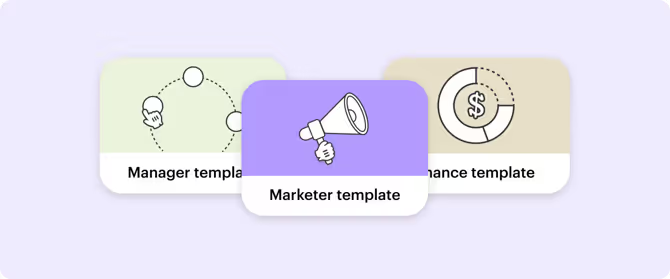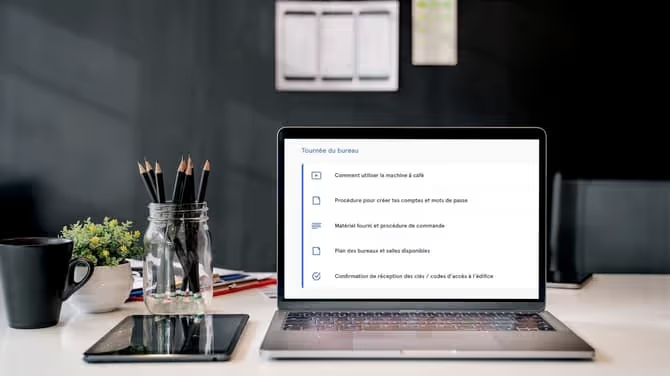How to onboard a new manager (with template)

Streamline, organize, and automate your onboarding process like magic.

Hiring a new manager comes with its own set of challenges. However, there are also a lot of ways that hiring a manager is similar to hiring an entry or mid-level employee. The main thing that they have in common is that they’re both hard to do!
The onboarding of a new employee sets the tone for the next step in their career and has a fundamental impact on the success of your company in the near-future. This is a lot of pressure, and you shouldn’t have to do it alone. Fortunately, the hard task of onboarding becomes much less stressful with the help of a new manager onboarding template.
Before we get to that, though, let’s look at some of the tried-and-true best practices that can show us how to onboard a manager.
Why a Proper Onboarding is Important for New Managers
It’s common knowledge that new employees need onboarding. But sometimes, when employees are hired at a managerial level, there’s an assumption that they know how to do their jobs and don’t need to be onboarded in the same way an entry-level employee would be. Unfortunately, this pervasive attitude couldn’t be further from the truth.
Expecting our managers to know everything from day one not only puts unfair expectations on them but also doesn’t allow time for the rest of your team to adjust to their new colleague. Here are some other reasons why the onboarding process is just as important for those stepping into a middle or senior management position:
Managers have impact
If you wanted to do an experiment to see how quickly you can get an employee to quit, put them under the guise of a bad manager. Okay, so you probably wouldn’t want to do this experiment, but just humour us for a moment and imagine you would.
There are few — if any — components of a job that have the same impact as the influence of a manager. Have a competent and kind manager team, and you’ll see team morale soar. Employ a set of micromanaging, over-critical bosses, and chances are that you’ll see your turnover rate skyrocket.
None of us enter the world as infants who are “natural managers”. Although some innate soft skills lend themselves well to management — like empathy or active listening — there are many skills that must be taught. If you don’t offer your new manager an onboarding experience that sets them up for success, prepare to see a wave of negativity ripple through your organization.
Although managers are taking on a senior position in your company, they still need the onboarding period to learn the company values. An onboarding period also gives them a chance to determine the best way that their management style will fit in with the overall organization.
Employee retention
It’s hard to hire for manager-level positions. In fact, it’s hard to hire in general, and the pandemic has only made it harder. According to a study released by Goldman Sachs, 87% of surveyed small businesses said that it’s difficult to find qualified candidates to hire. What’s more is a staggering 97% said that this struggle in hiring impacts their bottom line.
With this much on the line, hiring managers and their companies are looking for ways to keep quality talent once they find it. When you consider that businesses with a standardized onboarding approach have a 50% higher retention rate, pouring time into onboarding is a no-brainer.
Context switching
An onboarding experience is important even if you’re promoting from within. Although this internal employee would be familiar with your company’s operations, the new job is still an adjustment. An onboarding process will give them time to learn about their new role and give them a “buffer” between the two roles so it doesn’t feel like they’re being thrown from one role to another.
What to Include in a Successful Onboarding
Your exact new manager onboarding checklist will look different depending on the needs of your organization. But every experience should have the following components:
Pre-boarding
So you’ve found the perfect new manager to join your tight-knit team. Everyone is anxiously awaiting their arrival. There is nothing to do but anticipate, right?
Not quite. The time between the moment you make a hire and their first day is actually a very important part of the overall onboarding process. It’s called “pre-boarding”, and it’s the best time to set a positive first impression for your new hire.
The pre-onboarding period is a great time to provide your new hire with the basics that they need to know before they get started. Here are some ways that you can give your new hire a pleasant pre-boarding experience:
- Send a warm welcome email that congratulates the new hire on their position and clearly outlines their start date and time
- Provide a preview of what the first week will look like (or, even better, send them their onboarding schedule ahead-of-time)
- Send a copy of the employee handbook
- Set up their new computer and account accesses
- Send out a welcome package with branded items
- Choose a mentor for your newcomer
- Announce the new hire to your internal team
Onboarding
As an HR professional, this is your time to shine. While you might only use the first week for introductory tasks, it’s important to remember that the average onboarding process actually takes a few months (and it takes at least a year for an employee to realize their full potential)!
The best onboarding experiences include:
- Employee introductions
- Daily check-ins
- Establishment of rituals (like weekly check-ins with other team members)
- Company social gatherings
- Meeting other managers
- Learning the basics of the job
- Learning more about the company
Training
Contrary to popular belief, onboarding and training are not interchangeable. Training includes things like:
- Sharing documentation and processes
- Briefing new hires on any new software
- Setting expectations and goals
- Mentorship, collaboration, and room for asking questions
How to Spot a Great Onboarding
Sometimes it’s better to show, not tell—here are some great new manager onboarding examples.
Example 1: the Remote Manager
- Send new employees a care package filled with useful items (like pens and paper) and items that represent the company’s culture (like a pass to a local sports club or a book).
Finding some time to set up face-to-face virtual meetings with new coworkers is great, too. If time won’t allow for that, a pre-recorded video welcome message from new employees is a good idea (especially when followed by a face-to-face interaction). - Set up incremental reminders for check-ins and feedback sessions.
- Provide one-on-one training on any software or communication tools that your company uses.
A social aspect is an important part of any onboarding, and remote work is no exception. There are plenty of fun team games you could make use of during this remote onboarding session — skibbl.io is a popular drawing game that leads to lots of laughs.
Example 2: the In-Office Manager
- Start the day with an office tour—nobody likes to be disoriented.
- Make sure that you send out an email (or other message) to your team introducing them to the new face around the office. Try to set up organized times for colleagues to interact with one another, so that your new hire isn’t bombarded with countless introductions in their first days.
- Consider a fun interactive game that allows you to take advantage of the fact you’re in-office.
- Set your new hire up with a “buddy” who can take them to lunch and introduce them to colleagues—this is a must if you have a large office.
SoftStart’s new manager onboarding template was created by actual managers and HR experts. It’s fully-customizable, so feel free to use it as a starting point and build off of it so that it best serves you and your team. This particular template is designed with the manager’s experience in mind—a demographic often left out of the onboarding discourse.
%20(1).png)

%20(1).avif)


.avif)
.avif)








